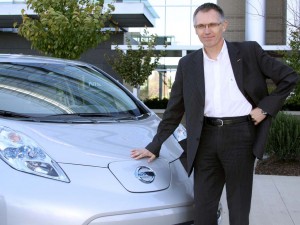
Battery-electric vehicles will account for 10% of the global automotive market by 2020, contends Carlos Tavares, EVP of Nissan in America.
The push to zero-emission vehicles is inevitable, a senior Nissan executive declared during a visit to Detroit, on Monday, just weeks before the maker formally launches sales of its first mass-market battery-electric vehicle, the 2011 Nissan Leaf.
By 2020, forecast Carlos Tavares, executive vice president of Nissan in America, pure battery-electric vehicles, like the Leaf, will account for 10% of worldwide vehicle sales. Considering global volumes are expected to reach perhaps 65 to 70 million by the end of the decade, that would mean sales of perhaps 7 million BEVs annually – a figure significantly in excess of what many other industry leaders are projecting.
“You won’t be surprised if we disagree,” Tavares said, referring to several recent surveys that took a more pessimistic view of the potential market for battery power.
One of the most widely quoted, J.D. Power and Associates’ new Drive Green study, predicts all forms of battery propulsion, including conventional hybrids, plug-ins and battery-electrics, will generate just 7.3% of global sales by 202, with BEVs accounting for barely a third of the overall market. (Click Here for that story.)
While Tavares said Nissan is aware of the “tough challenges,” he argued that there is now a “once-in-a-lifetime” opportunity to bring pure electric propulsion into the mainstream. But critical to achieving that goal are factors that include:
- The development of better, lower-cost batteries;
- The creation of a smart infrastructure to handle the switch and manage the distribution of electric power; and
- The establishment of a nationwide network of public charging stations.
Speaking to the Detroit Automotive Press Association, Tavares noted that, by the end of 2012, Nissan will have the capacity to produce 150,000 copies of the new Leaf each year at the maker’s plant in Smyrna, Tennessee. A nearby battery plant will, by then, be ready to roll out 200,000 lithium-ion battery packs annually.
(Click here for TheDetroitBureau.com’s review of the 2011 Nissan Leaf.)
By mid-decade, meanwhile, Nissan and its French alliance partner Renault, will have capacity to produce over 500,000 battery-electric vehicles worldwide.
Tavares confirmed plans to follow Leaf to market with two more battery cars: a small commercial van for Nissan, and a sporty model for the maker’s luxury marque, Infiniti. Longer-term, as the capabilities of electric propulsion improve, he suggested, Nissan will begin offering the technology in other market segments, with a goal of eventually using battery power across its line-up.
At $32,780, the 2011 Nissan Leaf carries a fair premium over competing compact models, something that will be offset, initially, by $7,500 in federal tax credits. And there are additional credits and incentives available in various parts of the country that could, under the right situation, reduce the out-of-pocket cost for a Leaf to as little as $12,280. (Click Here to find out how and where.)
But longer-term, the Nissan EVP acknowledged, those incentives will go away and products like Leaf will have to compete on their own. But if the price of battery technology comes down, BEVs will have a number of advantages, said Tavares, beyond their zero emissions. He projected that Leaf will cost perhaps a third as much to maintain as a Toyota Prius hybrid, and a quarter of what it takes to run a conventional gasoline vehicle, per mile.
Leaf has become the four-wheeled symbol of the Nissan brand, in recent months, helping create a clear identity for a brand whose image had become muddled over the years.
“Something went wrong,” Tavares lamented, suggesting that to have a clear brand identity a maker must have “persistence and consistency,” in its marketing message and product offerings – while “also being relevant.”
Leaf is helping Nissan pull its brand message back in line but even before the new battery car hits market the maker is posting significant gains. Together with Infiniti, its U.S. sales have jumped 16% this year, while their combined market share has jumped from 7.4% to 7.8% for the calendar-year-to-date. For the 41 markets in the Americas where Nissan competes the company’s share has jumped from 6.6% to 7.1% over the past 12 months. In Mexico, Tavares boasted, Nissan is the number one brand, with a 23.1% share.
During a Q&A session with reporters, Tavares said he sees conventional hybrids, plug-ins and other high-mileage, low-emissions technologies as a natural progression towards a “zero-emissions society,” but while he said Nissan is looking at conventional hybrids, diesels and turbos for its fleet it has no plans to offer plug-in hybrids or extended-range electric vehicles, such as the Chevrolet Volt, to which the Nissan Leaf is being frequently compared.
Leaf won’t do much to build those numbers, at least not initially, with first-year allocations limited to about 20,000 vehicles. But demand has exceeded even Nissan’s optimistic expectations. The maker recently cut off a pre-order registration process three months ahead of schedule.
Separately, Tavares confirmed a story, first reported by TheDetroitBureau.com, that Nissan is considering offering Leaf buyers a loaner program in which they could use a more conventional vehicle for a week each year when, for example, they might need something larger or with longer range than Leaf’s 100 miles per charge. (Click Here for the original report.)
“We’re considering the loaner program,” the Portugese-born executive said, adding that a decision “will be concluded, positively or negatively, within a couple of months.”
